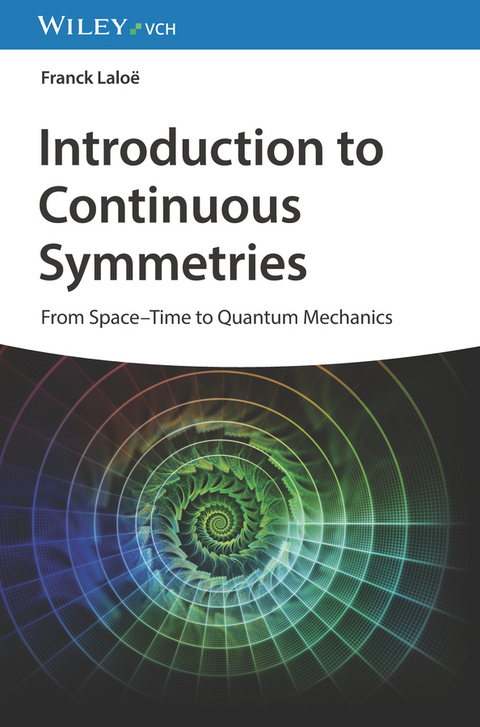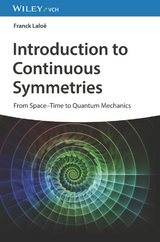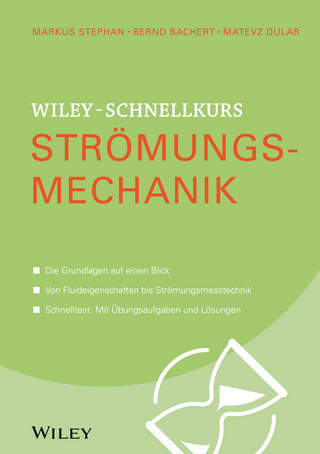Introduction to Continuous Symmetries
Wiley-VCH (Verlag)
978-3-527-41416-1 (ISBN)
Introduces powerful symmetry-based approaches and computational methods essential for describing and understanding phenomena in high-energy physics, quantum optics, quantum information, and solid-state physics.
The new book by Franck Laloe introduces a symmetry-based approach to understand quantum mechanics at a fundamental level and provides the associated computational techniques to master advanced courses on nuclear physics, quantum optics and solid-state physics.
Symmetry considerations have always played a pivotal role in the physical sciences. Particularly in physics, there is an intricate, profound connection between abstract symmetries and concrete manifestations of physical phenomena: For instance, the Noether theorem proved that each conservation law, e.g., conservation of energy, momentum and angular momentum, is related to a symmetry of space-time. Thanks to a fruitful cross-fertilization between physics and mathematics, even the elusive quantum mechanics can be understood by utilizing discrete and, in particular, continuous symmetries.
Consequently, geometrical, symmetry-based approaches to physics are part of many graduate curricula in theoretical physics, laying the foundation for students to start a career in vibrant research fields such as quantum technology, high-energy physics or solid-state physics.
This new book by Franck Laloe, co-author of the seminal Cohen-Tannoudji/Laloe/Diu quantum mechanics textbooks, unravels the mysteries of quantum mechanics by showing that the underlying equations naturally emerge from very general symmetry considerations without recourse to seemingly artificial and ambiguous quantization rules. Graduate students are familiarized with computational techniques based on rotation invariance, irreducible tensor operators, the Wigner-Eckart theorem, Lie groups etc. that are indispensable to master nuclear physics, quantum optics and advanced solid-state physics.
Written in a didactically unrivalled manner, the textbook explains the fundamental concepts in ten chapters which are elaborated in accompanying complements that provide more detailed discussions and examples.
Franck Laloë is a researcher at the Kastler-Brossel laboratory of the Ecole Normale Supérieure in Paris. His first assignment was with the University of Paris VI before he was appointed to the CNRS, the French National Research Center. His research is focused on optical pumping, statistical mechanics of quantum gases, musical acoustics and the foundations of quantum mechanics.
I Symmetry Transformations
A Fundamental Symmetries
B Symmetries in Classical Mechanics C Symmetries in Quantum Mechanics
A_I Euler's and Lagrange's Views in Classical Mechanics
1 Euler's Point of View
2 Lagrange's Point of View
II Notions on Group Theory
A General Properties of Groups
B Linear Representations of a Group
A_II Residual Classes of a Subgroup; Quotient Group
1 Residual Classes on the Left
2 Quotient Group
III Introduction to Continuous Groups and Lie Groups
A General Properties B Examples
C Galileo and Poincaré Groups
A_III Adjoint Representation, Killing Form, Casimir Operator
1 Representation Adjoint to the Lie Algebra
2 Killing Form; Scalar Product and Change of Basis in L
3 Totally Antisymmetric Structure Constants
4 Casimir Operator
IV Representations Induced in the State Space
A Conditions Imposed on Transformations in the State Space
B Wigner's Theorem
C Transformations of Observables
D Linear Representations in the State Space
E Phase Factors and Projective Representations
A_IV Finite-Dimensional Unitary Projective Representations of Related Lie Groups
1 Case Where G is Simply Connected
2 Case Where G is P-Connected
B_IV Uhlhorn-Wigner Theorem
1 Real Space
2 Complex Space
V Representations of the Galileo and Poincaré Groups: Mass, Spin and Energy
A Galileo Group
B Poincaré Group
A_V Some Properties of the Operators S and W_2
1 Operator S
2 Eigenvalues of the Operator W_2
B_V Geometric Displacement Group
1 Reminders: Classical Properties of Displacements
2 Associated Operators in the State Space
C_V Clean Lorentz Group
1 Link with the Group SL(2,C)
2 Small Group Associated with a Four-Vector
3 Operator W_2
D_V Space Reflections (Parity)
1 Action in Real Space
2 Associated Operator in the State Space
3 Retention of Parity
VI Construction of State Spaces and Wave Equations
A Galileo Group, Schrödinger Equation
B Poincaré Group, Klein-Gordon and Dirac Equations
A_VI Lagrangians of Wave Equations
1 Lagrangian of a Field
2 Schrödinger's Equation
3 Klein-Gordon Equation
4 Dirac's Equation
VII Irreducible Representations of the Group of Rotations, Spinors
A Irreducible Unitary Representations of the Group of Rotations
B Spin 1/2 Particles; Spinors
C Composition of the Kinetic Moments
A_VII Homorphism Between SU(2) and Rotation Matrices
1 Transformation of a Vector P Induced by an SU(2) Matrix
2 The Transformation is a Rotation
3 Homomorphism
4 Link to the Reasoning of Chapter VII
5 Link with Bivalent Representations
VIII Transformation of Observables by Rotation
A Vector Operators B Tensor Operators
C Wigner-Eckart Theorem
D Decomposition of the Density Matrix on Tensor Operators
A_VIII Basic Reminders on Classical Tensors
1 Vectors
2 Tensors
3 Properties
4 Tensoriality Criterion
5 Symmetric and Antisymmetric Tensors
6 Special Tensors
7 Irreducible Tensors
B_VIII Second Order Tensor Operators
1 Tensor Product of Two Vector Operators
2 Cartesian Components of the Tensor in the General Case
C_VIII Multipolar Moments
1 Electrical Multipole Moments
2 Magnetic Multipole Moments
3 Multipole Moments of a Quantum System for a Given Kinetic Moment Multiplicity J
IX Groups SU(2) and SU(3)
A System of Discernible but Equivalent Particles
B SU(2) Group and Isospin Symmetry
C Symmetry SU(3)
A_IX the Nature of a Particle Is Equivalent to an Internal Quantum Number
1 Partial or Total Antisymmetrization of a State Vector
2 Correspondence Between the States of Two Physical Systems
3 Physical Consequences
B_IX Operators Changing the Symmetry of a State Vector by Permutation
1 Fermions
2 Bosons
X Symmetry Breaking
A Magnetism, Breaking of the Rotation Symmetry
B Some Other Examples
APPENDIX
I The Reversal of Time
1 Time Reversal in Classical Mechanics
2 Antilinear and Antiunitary Operators in Quantum Mechanics
3 Time Reversal and Antilinearity
4 Explicit Form of the Time Reversal Operator
5 Applications
| Erscheinungsdatum | 16.08.2023 |
|---|---|
| Übersetzer | Nicole Ostrowsky, Daniel Ostrowsky |
| Verlagsort | Weinheim |
| Sprache | englisch |
| Maße | 170 x 244 mm |
| Gewicht | 1240 g |
| Einbandart | gebunden |
| Themenwelt | Naturwissenschaften ► Chemie |
| Naturwissenschaften ► Physik / Astronomie ► Theoretische Physik | |
| Schlagworte | Applied Mathematics in Science • Chemie • Chemistry • Mathematics • Mathematik • Mathematik in den Naturwissenschaften • Physics • Physik • theoretical physics • Theoretische Physik |
| ISBN-10 | 3-527-41416-9 / 3527414169 |
| ISBN-13 | 978-3-527-41416-1 / 9783527414161 |
| Zustand | Neuware |
| Informationen gemäß Produktsicherheitsverordnung (GPSR) | |
| Haben Sie eine Frage zum Produkt? |
aus dem Bereich




